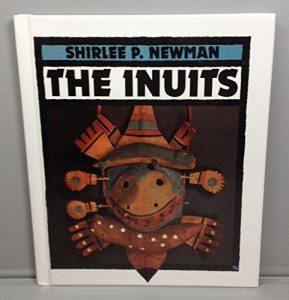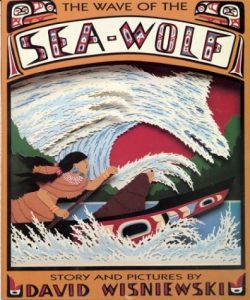 Sent out by his grandmother to find food, Amik consumes a series of animals of ever-increasing size and brings back more than he thinks.
Sent out by his grandmother to find food, Amik consumes a series of animals of ever-increasing size and brings back more than he thinks.
Indigenous
The Inuits (First Books)
The Wave Of The Sea-Wolf
Tales Of the Amazon: How the Munduruku Indians Live
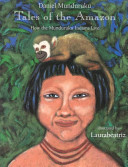
A member of a local Amazon tribe takes readers deep into the heart of Brazil in this lavish picture book. First, we meet a young Munduruku boy and discover how he is trained in the sacred ways of a shaman. In the second part, the author recounts his journey to the city after growing up among the trees and animals of the jungle, describing what he found there and how the people he met treated him. Part three offers a portrait of Amazonian culture – how they live, their legends, and their language.
Living In The Amazon Rainforest
The Yanomami have lived in the rain forest for thousands of years. They live in villages where many families share one big hut. You will read how they have learned special skills to survive in the rain forest.
The Queen of Water
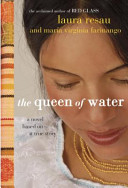
Born in an Andean village in Ecuador, Virginia lives with her large family in a small, earthen-walled dwelling. In her village of indígenas, it is not uncommon to work in the fields all day, even as a child, or to be called a longa tonta—stupid Indian—by members of the ruling class of mestizos, or Spanish descendants. When seven-year-old Virginia is taken from her village to be a servant to a mestizo couple, she has no idea what the future holds. In this poignant novel based on a true story, acclaimed author Laura Resau has collaborated with María Virginia Farinango to recount one girl’s unforgettable journey to self-discovery. Virginia’s story will speak to anyone who has ever struggled to find his or her place in the world. It will make you laugh and cry, and ultimately, it will fill you with hope.
The Dreamer
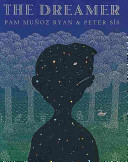
A fictionalized biography of the Nobel Prize-winning Chilean poet Pablo Neruda, who grew up a painfully shy child, ridiculed by his overbearing father, but who became one of the most widely-read poets in the world.
The Good Rainbow Road
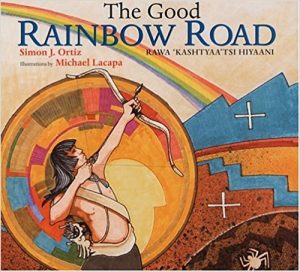 This is the story of two courageous boys and of how they saved their village, Haapaahnitse, Oak Place, and it lies at the foot of a mountain. Once there was a lake and a stream nearby, but they have dried up. The land has become barren and dry. Two brothers, Tsaiyah-dzehshi, whose name means First One, and Hamahshu-dzehshi, Next One, are chosen for a westward trek to the home of the Shiwana, the Rain and Snow Spirits, to ask them to bring the gift of water to the village again. The brothers cross deserts and mountains on an arduous journey until they are finally stopped short by a treacherous canyon filled with molten lava. “The Good Rainbow Road” tells how the brothers overcome this last challenge and continue on to their destination.
This is the story of two courageous boys and of how they saved their village, Haapaahnitse, Oak Place, and it lies at the foot of a mountain. Once there was a lake and a stream nearby, but they have dried up. The land has become barren and dry. Two brothers, Tsaiyah-dzehshi, whose name means First One, and Hamahshu-dzehshi, Next One, are chosen for a westward trek to the home of the Shiwana, the Rain and Snow Spirits, to ask them to bring the gift of water to the village again. The brothers cross deserts and mountains on an arduous journey until they are finally stopped short by a treacherous canyon filled with molten lava. “The Good Rainbow Road” tells how the brothers overcome this last challenge and continue on to their destination.
“The Good Rainbow Road” is presented in Keres, the language of Acoma Pueblo and six other Pueblo communities in New Mexico, and in English, with an additional Spanish translation in the back of the book. It is published in cooperation with Oyate, a community-based Native organization dedicated to the continuation of traditional literatures and histories.
The Navajo Year Walk Through Many Seasons
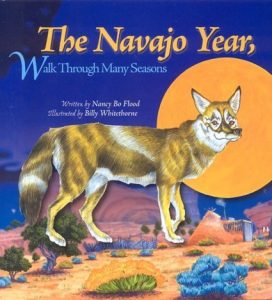 For the Navajo people, the new year begins in October, when summer meets winter. The Navajo Year, Walk Through Many Seasons follows the Navajo calendar, and provides poetic descriptions of the many sights, sounds, and activities associated with each month. In November, there are string games and stories; in April, planting of corn, beans, and squash; and in July, rodeos and monsoon rains. Follow Coyote through the year, and explore how the Navajos observe the rites and passages of each month.
For the Navajo people, the new year begins in October, when summer meets winter. The Navajo Year, Walk Through Many Seasons follows the Navajo calendar, and provides poetic descriptions of the many sights, sounds, and activities associated with each month. In November, there are string games and stories; in April, planting of corn, beans, and squash; and in July, rodeos and monsoon rains. Follow Coyote through the year, and explore how the Navajos observe the rites and passages of each month.
The Inuit Thought Of It: Amazing Arctic Innovations (We Thought Of It)
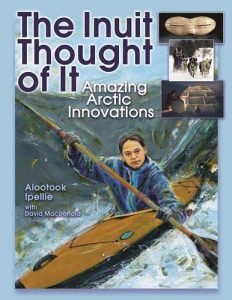 Dazzling inventions from the far north.Today’s Arctic communities have all the comforts of modern living. Yet the Inuit survived in this harsh landscape for hundreds of years with nothing but the land and their own ingenuity. Join authors Alootook Ipellie and David MacDonald as they explore the amazing innovations of traditional Inuit and how their ideas continue to echo around the world.Some inventions are still familiar to us: the one-person watercraft known as a kayak retains its Inuit name. Other innovations have been replaced by modern technology: slitted snow goggles protected Inuit eyes long before sunglasses arrived on the scene. And other ideas were surprisingly inspired: using human-shaped stone stacks (lnunnguat) to trick and trap caribou.Many more Inuit innovations are explored here, including: Dog sleds Kids’ stuff Shelter Food preservation Clothing Medicine.In all, more than 40 Inuit items and ideas are showcased through dramatic photos and captivating language. From how these objects were made, to their impact on contemporary culture, The Inuit Thought of It is a remarkable catalog of Inuit invention.
Dazzling inventions from the far north.Today’s Arctic communities have all the comforts of modern living. Yet the Inuit survived in this harsh landscape for hundreds of years with nothing but the land and their own ingenuity. Join authors Alootook Ipellie and David MacDonald as they explore the amazing innovations of traditional Inuit and how their ideas continue to echo around the world.Some inventions are still familiar to us: the one-person watercraft known as a kayak retains its Inuit name. Other innovations have been replaced by modern technology: slitted snow goggles protected Inuit eyes long before sunglasses arrived on the scene. And other ideas were surprisingly inspired: using human-shaped stone stacks (lnunnguat) to trick and trap caribou.Many more Inuit innovations are explored here, including: Dog sleds Kids’ stuff Shelter Food preservation Clothing Medicine.In all, more than 40 Inuit items and ideas are showcased through dramatic photos and captivating language. From how these objects were made, to their impact on contemporary culture, The Inuit Thought of It is a remarkable catalog of Inuit invention.

